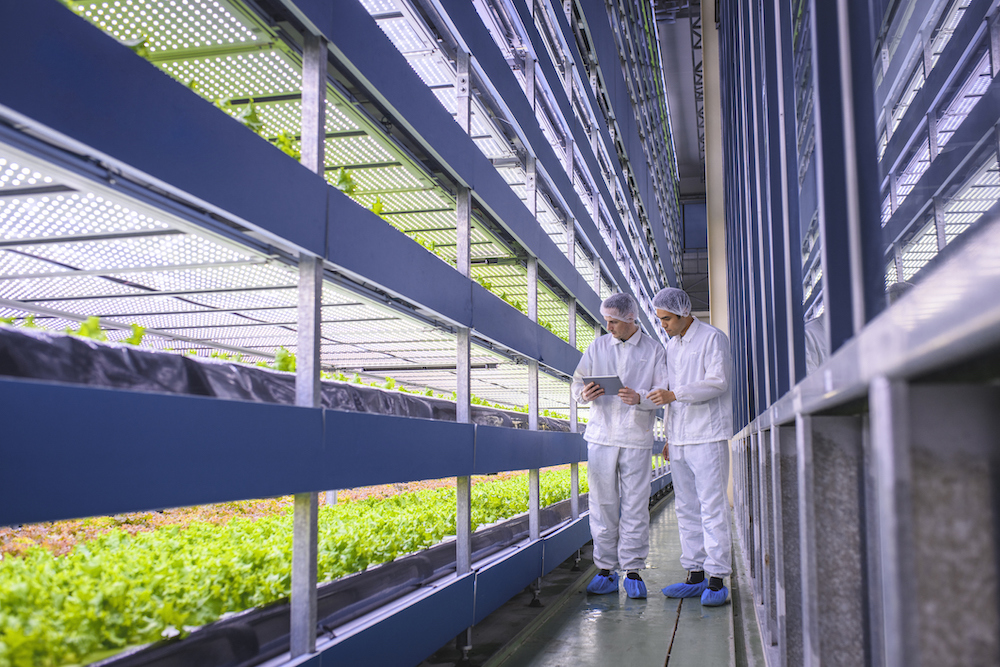- Vertical farming is booming as COVID-19 bolsters demand for locally-grown greens.
- Impact investors might find the sector appealing because the farms offer organic vegetables and fruit while using less water and land than conventional agriculture.
- There is a growing interest in vertical farming worldwide, with massive facilities already operating in Asia, the Middle East and Europe, and new projects announced since the start of the COVID-19 outbreak.
While many industries are contracting because of COVID-19, vertical farming is booming as it meets demand for locally grown kale and lettuce.
Vertical farms — indoor spaces where climate and light are tightly controlled — were already expanding in urban areas before the pandemic struck. Since they control everything from seed to store, vertical farms can provide skittish consumers with information about where their food comes from and how it’s produced. While crops rot in fields because of disruptions to farming and supply chains, vertical farms such as Bowery Farming and AeroFarms are boosting output.
“This pandemic exposed the fragility and vulnerabilities with our food supply system that have left people without access to fresh food when they need it most,” Irving Fain, CEO of Bowery Farming, told Karma. “Bowery is in a position to support our communities with fresher, safer produce during this time and beyond.”
Bowery Farms has been pairing technology with agriculture to boost yields and curb the need for water and other inputs. The startup’s software uses vision systems, automation technology and machine learning to constantly monitor plants. Bowery’s three farms, two in Kearny, New Jersey, about 10 miles from Manhattan, and one in Baltimore, use no pesticides, 95% less water and are more than 100 times more productive than traditional agriculture per acre.
“Our online sales have more than doubled and demand from our in-store retail partners has gone up 25-50%,” Fain said.
Vertical farms are sprouting in many urban areas. Another pioneering startup in the field, South San Francisco-based Plenty is building a new farm in the middle of Los Angeles. Orlando-based Kalera opened a second facility near the Orlando International Airport that is projected to produce about 6 million heads of lettuce per year.
“Vertical farming will see an economic boon due to increased localization and shortening of the supply chain to be more resilient to crises like COVID-19,” Henry Gordon-Smith, founder of Agritecture, a global urban farming consultancy, told Karma.
Vertical farming has hit speed bumps. It requires a massive input of capital to launch, and the output isn’t cheap. They are energy-intensive, although much more efficient than earlier because of LEDs. Solar panels have the potential to make them carbon neutral. Industry backers are not projecting that vertical farms will replace conventional agriculture anytime soon, but are bullish about its ability to fill a niche in urban areas.
The high upfront costs haven’t scared off investors. Bowery has raised $172.5 million from investors including GV, General Catalyst, GGV Capital, First Round Capital and Temasek. Plenty has raised $400 million, with backing from SoftBank’s Vision Fund, Bezos Expeditions, Innovation Endeavors and others. New Jersey-based AeroFarms in New Jersey raised $100 million in 2019 to expand its facilities.
The growth isn’t limited to the U.S., with large vertical farms found in such varied places as Singapore, Sweden and the United Arab Emirates. The pandemic has led to increased interest in urban agriculture. Singapore announced on April 15 that it will take steps to accelerate local food output because COVID-19 underscores the need for local food production.” Earlier in April, AeroFarms announced plans to build the world’s biggest R&D vertical farm in Abu Dhabi.
“In addition to the reduced distance to the consumer, indoor farms such as greenhouses and vertical farms have certain abilities to adapt to shocks in the system by changing their crops in hydroponic systems to adjust to demand,” Gordon-Smith said. “Relative to soil, these systems provide some advantages.”






















